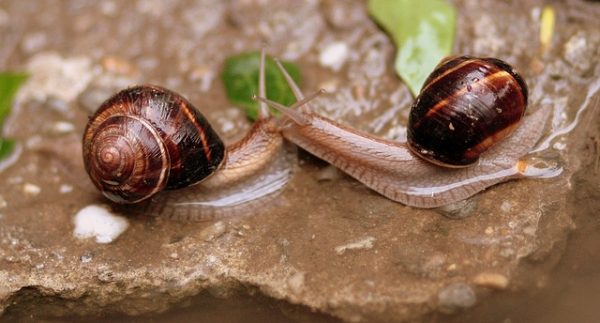The African Land Snail is one of the largest land univalves. They have an average lifespan of approximately 5 to 7 years. However, they tend to live much longer when they get favorable weather and enough food.
An African land snail originates from the African continent, of the genus Metachatina, Achatina, and Archachatina. There are different species of African snail including Archachatina marginata, Archatina fulica, Achatina reticulata, Archatina achatina among others.
The giant African snail’s body has two long tentacles with eyes and two short ones. An adult African snail weighs approximately 32 grams. Its shell measures 2.7-3.9 inches in height and 7.8 inches in length. The shell has a narrow and conical appearance, with 7-9 spirals visible on its surface. (Source )
)

The African snail color is not always uniform, as this depends on the environment where it lives. It can adopt a slightly dark brown color or reddish color with yellowish vertical stripes.
The African land snails have a tongue-like structure in their mouth called the radula that has small teeth, which helps the snail to scrap food before eating. They also have ‘muscular feet’ that ease their movement from one point to the other. The giant African snails release mucus while moving to reduce friction with the surface and avoid any form of tissue damage.
The shell is the point where the African land snails take refuge against predators. They will also retreat to their shells during harsh temperatures, such as during the night when temperatures begin to fall too low for their comfort.
Although African snails thrive in subtropical and tropical areas, they can also survive in wild cold regions. Transferring the snails in a warm environment may increase their eggs’ productivity to 1,200 eggs annually.
So, Can the gain African land snail be a pet? Asides from the USA and other countries like Japan and Australia, the giant African land snails are allowed to be sold and raised as pets in Africa (where they originate) European countries, and the UK. For countries like the UK, it is illegal to let them go into the wild or release their eggs inappropriately. A good way to dispose of these eggs is to freeze them before disposal.
As read further, you will get deep insight into how these snails feed, their habitat, distribution, behavior and so much more. You can read also on snail behavior in Snail Behavior and their Nature – Your Top Questions Answered .
.
To know more about handling the African Snail, check out Can people get sick from handling African snails? All you need to know about African snails and your health .
.
Feeding
The Africa land snail is a herbivore that does not discriminate between dead plant matter or living plant. It has a big appetite for all types of plants, feeding on more than 500 different types, including those planted in the farms.
They eat leaves, fruits, wood, nuts, stems, flowers, fungi, seeds, seaweed, lichens, coca, peanut, cauliflower, banana, cassava, papaya, and other dead snails. This explains why these animals can be destructive and dangerous to human nature.
African snails also require calcium-rich food to help them develop hard shells. Hence, they will eat some plant species to get calcium. In situations where they can’t get sufficient calcium from the plants they feed on, they may feed on the sand, small stones, or bones from carcasses to supplement calcium.
Read more about snail feeding from our article on the best food for snails .
.
Habitat and distribution
Although African snail is native to Africa countries such as Morocco, Ivory Coast, Ghana, Mozambique, Somalia, Kenya, and other surrounding islands, they have been introduced to other countries across the globe over time.
These countries include Australia, China, Japan, Sri Lanka, Malaysia, New Zealand, Fiji, New Guinea, Vietnam, Bangladesh, Indonesia, Hawaii, and Vanuatu. The African snail species are spread across all continents except Antarctica.
They thrive in humid and hot climatic regions. In Africa, the snails are mostly found along the forest edges but can also be found in streams and riverbanks, plantations, wetlands, agricultural areas, shrublands, and gardens.
The behavior of African snails
African snails are more active at night and remain dormant during the day. During dormancy, the snails often bury themselves beneath the ground as a measure to stay away and be safe from predators.
African snails are not social species. They live a lonely life and fail to bond with their offspring even after hatching the eggs. They don’t socialize with each other except during mating. The African land snails do not produce any sound within their dwelling, and they spend most of their time resting, moving, and feeding.
They are more active during temperatures ranging between 9 and 29 degrees Celsius. However, they can survive even in cold temperatures above 2 degrees Celsius by hibernating inside their shells. They slow down their metabolism during cold temperatures and limit their movement and feeding during this period.
They remain inside their shells for several months before coming out again to feed and move.
Sometimes, the African snails may estivate during the summer months to try and escape the hot weather conditions. They keep their body moist by creating a thin layer of mucus barrier. When there are server drought conditions, this process may take longer, up to three years.
Reproduction
The African snails are hermaphrodites, meaning that they have both reproductive organs (male and female). This means that they have the capability of self-fertilizing, but they usually don’t do this. They mate traditionally. However, immature snails may sometimes produce spermatozoa only, while adult snails can produce eggs.
Coupling among the snails often takes place at night, when they are most active.
In about 8 to 20 days after mating, the African snails lay 100 -500 eggs in a nest between the rocks, beneath the ground and vegetation. They lay eggs every 2 to 3 months. However, the hatched offspring receive no care from their parents, defining the poor social nature of the African snails. (Source )
)
African snails do not have a regular or defined breeding period. Averagely, they lay 5 to 6 clutches of eggs yearly, containing 200 eggs per clutch on average.

Our article on snail reproduction gives more details on how snails reproduce.
gives more details on how snails reproduce.
Can giant African snails be pets?
The African snail species is a dangerous pest both at home and in agriculture as they can transmit diseases to both mankind and animals given the parasites it harbors. For an extended period, people have tried coming up with different management and control strategies to control their population.
In countries like the USA, it is against the laws to keep African snails as pets because of the danger they pose. On contrary, some people hunt these animals for consumption, a practice that is highly prohibited as it is hazardous to health.
Asides from the USA and other countries like Japan and Australia, the giant African land snails are allowed to be sold and raised as pets in Africa (where they originate) and in European countries like the UK. For countries like the UK, it is illegal to let them go into the wild or release their eggs inappropriately. A good way to dispose of these eggs is to freeze them before disposal. (Source )
)
Importing and exporting African snails in the USA
It is illegal to import live African snails into the United States of America for human consumption. Frozen, cooked, or processed snails may be imported instead. You will require a business permit from the United States Department of Agriculture (USDA) to carry out such importations. (Source )
)
The USDA body prohibits importation or exportation of the African snail because it poses a great risk to the US human and agricultural health. The African snail is one of the most destructive snails across the globe, and it feeds on over 500 different plant species including beans, cucumber, melons, peanuts, and peas.
They also feed on a vast range of tree barks, ornamental plants, paint, and even stucco on houses. In case you are caught trying to import an African snail into the USA, you will be fined by the USDA.
Other than the African Snail, some countries also ban Apple Snails due to invasive behavior.
due to invasive behavior.
Handling African snails

African snails are almost harmless; however, you must be very careful when handling them to avoid damaging their shell. You should moisten your hands before holding the snails to avoid causing harm.
The base section of the shell is the most fragile part. Therefore, you should refrain from picking the snails up by the base of the shell and ensure you provide sufficient support to the shell and body.
It is also advisable that you wear gloves when handling the African land snails. This is because it is believed that snail ooze or slime contains parasites that can turn toxic to human health. For this reason, you are advised to always wash your hands well after handling African snails.
Can African land snails bite?
Concerning handling African snails, you might be wondering if these snails bite. No, they don’t as these African land snails don’t have teeth. However, they have a rough tongue-like structure called a radula that has special ridges to help the snails rasp their food instead of biting or chewing.
The radula is a relatively rough, tickly sensation that has a licking feel. The licking or rasping feel is harmless. You can only feel an African snail rasping you, but they do not bite.
Final Thoughts
The African snails are very adaptive, invasive creatures that constitute a great threat to natural resources, human health, and crops. They feed on over 500 different plant species, including common vegetables, ornamentals, and fruits. They are also known to feed on stucco and house paint.
The African snail may also carry several animal and plant pathogens, including a nematode parasite capable of causing human meningitis.
The spread of snails in a particular region is limited by moisture and cold temperatures, as well as the availability of soil calcium that is necessary for its shell formation. Part of the threat posed by the African snails is the ability to reproduce very fast. They reach reproductive age as early as 5 to 6 months period and live nearly a decade.
Although the African snail mate to reproduce, the adult snails have both female and male sexual organs. After just a single mating, the snail can lay multiple batches of eggs totaling more than 1200 eggs per year per snail.

